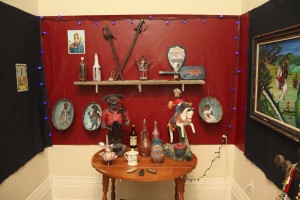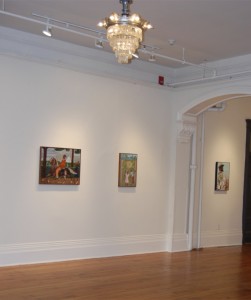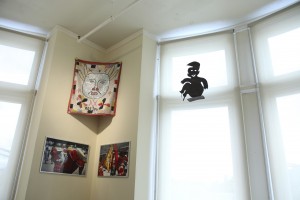 By Adebe DeRango-Adem
By Adebe DeRango-Adem
“Without question, carnival had become a symbol of freedom for the broad mass of the population and not merely a season for frivolous enjoyment. It had a ritualistic significance, rooted in the experience of slavery and in the celebration of freedom from slavery…..Adopted by the Trinidad people it become a deeply meaningful anniversary of deliverance from the most hateful form of human bondage
-Professor Errol Hill in The Trinidad Carnival, 1972.
Originally from Guyana, Nation speaks to SWAY about the inspiration behind his debut exhibit, and his own experience of Carnival from a multitude of perspectives.
DeRango-Adem: Your debut photography exhibition at the ROM is a retrospective look at the history of Caribana (now Scotiabank Toronto Caribbean Carnival) in Toronto, and the cultural legacy behind Carnival. What inspired you to put this exhibition together?
Cheong: I started documenting Caribana after reading the book Trinidad Carnival by Jeffrey Chock in 2007. The images moved me so much to want to deepen my understanding of the cultural significance of Carnival and the history of all its permutations. The intention has always been to publish a powerful book documenting Toronto’s Caribana and the history of the Caribbean families who immigrated to Toronto. This exhibit came about after Karen Carter the ED of Heritage Toronto and Chair of Black Artist Network in Dialog (BAND) contacted me to inquire if I had any Caribana photos that could be part of an exhibit that would mark the history of Caribana from 1967 to today.
How has your work as a community activist and musician factored into your debut as a photographer?
Community activism brings me closer to the impact of social injustices that break people’s spirit or bring out the divine in them; it is these broken and divine expressions, emotional and physical expressions of liberation, resistance, transcendence, joy and innocence that I seek to record. My music allows me to tap in to the rhythm of a space very quickly and it allows me to dance with the events unfolding around me.
Have you ever played Mas?
I’ve not yet found a local Mas Band that has produced a costume that speaks to me. After seeing Brian McFarlane’s Mas in 2009, however, I know it’s possible to have a costume with social value that I would be proud to wear. Locally, I love what Ricardo McRae is doing by preserving the jab jab tradition here in Toronto.
Despite combining archival photos and film and more recent visuals, your work seems to insist that carnival is not an archaic type of folksong fit for the archives. Would you say this is the case? How has carnival kept abreast of changing conditions and remained a contemporary cultural expression for those of Caribbean ancestry?
I would like to see more social and politically conscious Mas here in Toronto to keep the equally important bacchanalian spirit in balance. I think there is a real danger of first, second and third generation Canadians of Caribbean descent losing touch with the sociopolitical expressions of Carnival. Ras Stone, a local Trinidadian artist, is doing very conscious work that celebrates the emancipation spirit of Carnival. This year he created a float for Kiddy Carnival that was a tribute to the Marcus Garvey. This year’s Caribana will also have a Rasta float for the very first time. These are both encouraging examples of folks keeping the conscious spirit alive. We have a great opportunity every year to remind people of our past, to celebrate our diversity and to promote love and understanding among the many nations that celebrate Carnival, despite colour, class, creed and sexual orientation
As much as people around the world enjoy the carnival as a unique celebration of culture, there is a political dimension behind the music and performances. How you would describe this dimension to those just learning about carnival history?
The old calypso’s like Sparrow’s 1959 Paye up to David Rudder’s 1988 Panama and Ella Andall’s 2007 Black Woman are a small examples of the type of consciousness that lives in Calypso music. Soca is party music that should not be ever confused with the musical tradition that preserves the place of the African Griot that survived the trans-Atlantic slave trade.
Calypso was initially used a social outlet that would give rise to a national theatre predicated on a sense of collective memory. How does photography allow for a passing on of memory? Are photographs performances themselves, in the sense that they re-enact and re-call history?
Photographs are a static record of a moment in time that exemplifies humanity or nature at its best, worst or most mundane. It’s an art form that preserves important moments that trigger deeper and more fluid, complex memories. Our collective experiences and memories are the makings of history, and a photo can remind us of those important, perhaps transformative moments.
Toronto’s Carnival: Festival Photographs from 1967 to Today runs between July 16th and August 1st in the Hilary and Galen Weston Wing, Level 2. It is part of the duo-location exhibit, also featuring at The Gladstone Hotel until July 31. In this exhibition, Cheong’s contemporary work captures and communicates the myriad of experiences that have been a part of the Carnival experience in Toronto from its roots in 1967 to today.
Further Reading:
- CARIBANA: African Roots and Continuities – Race, Space and the Poetics of Moving –An essay by M. NourbeSe Philip which traces the history of Toronto’s Caribana, it’s model in Trinidad, it’s African origins and it’s raison d’etre. This genre crossing “essay” includes poetry, has fictional characters like a short story and is written in the rhythm and language of the Trinidadian demotic.

Alia Toor
Magic Squares: The patterned imagination of Muslim Africa in contemporary culture. From the collection of Islamic African artifacts with work by contemporary artists Hamid Kachmar, Jamelie Hassan, Alia Toor and Tim Whiten at The Textile Museum of Canada, Toronto.
By Anya Wassenberg
Magic Squares is an imaginative exhibition that begins with the “magic square” concept and then looks at its application and added meaning in African Muslim cultures and beyond, including the responses of four contemporary artists to the magic square concept as the intersection of design, belief and art.
Popular games like Sudoku and Kenken are based on the magic square, which originated in China about two thousand years ago. It is believed that it migrated to Africa via Muslim traders on the old Silk Road back through the Middle East and then Western and Northern Africa, as those regions converted to Islam in the 10th century. Here, the abstract mathematical concept combined with the long established weaving arts native to an area with an abundance of materials like cotton, silk and wool, and resulted in a mesmerizing expression of design.
Africans added a talismanic meaning. Magic squares, called “hatumere” were talismanic prayer papers which were sewn into clothing. Sometimes the piece of clothing itself would be adorned with symbols or phrases. The art of calligraphy and its use in decoration is a distinctive feature of Islamic design, often combined with geometric patterning on architecture, ceramics and textiles. One of the pieces on display is a cloth that was woven to commemorate the mosque at Touba, Senegal, central to the Mouride Sufi brotherhood. The pattern features rows that alternate an image of the mosque with script that says “There is no other God but Allah”, all of it over a checkerboard patterned background.
The exhibition contains many examples of blankets or wrappers, garments that cover the body literally from birth into old age and then act as a shroud when it’s finally laid to rest. In wraps from the Ewe people of Ghana, the Djula of Cote d’Ivoire, the Yoruba and Hausa of Nigeria and more, the geometric grid or checkerboard pattern comes to life in colour and cloth.
The majority of them are strip-woven, a technique common to much of the African continent. The looms are handheld and produce narrow bands of cloth which are then sewn together to create the larger pieces that form garments and blankets. The process allows the magic square patterning and alternating checkerboard effect to come naturally as the bands of cloth are assembled. Some involve strictly linear or geometric designs, while others include rounded elements and flourishes along with lettering.
The techniques used to create the patterns are amazingly intricate. In the Yoruba culture of Nigeria, the cloths are called adire. Here, the patterns are produced by stitching, stenciling, or treating plain cloth with a paint resistant substance. The cloth is then dyed with indigo. One example featured lettering that had been hand stitched through two layers before dying, the result a shimmering and teasingly inscrutable pattern of letters in deep blues. Garment fabrics often involve a basic stripe consisting of geometric checkerboarding as a background to embroidery at a neckline or sleeve.
The use of a grid to contain the patterning is symbolic of a culture that valued the rule of order and reason over chaos, a theme that’s taken up by Hamid Kachmar, one of the contemporary artists in the show, in his piece Tiswingimin. Hamid is himself from South Morocco, and not surprisingly, his is the piece that most resembles the work of the African artisans, consisting of 20 squares in two rows decorated with henna and saffron in a variety of very intricate patterns. It has a hypnotizing effect, glowing in reds and ochres even as the energy of the patterning is contained within its geometry. The title means “meditations” in Amazigh.
North Africa has long been noted for producing skilled leatherwork, and the magic square pattern appears in Tuareg leather piecesfrom Algeria that use embellishments like incising, embossing, braiding, tussling and dying. Other embellishments, like knotting, can also have spiritual meaning, as in the hunter’s coat from Mali on display. It’s made of cotton and decorated with amulets, mirrors and knotted cords, each element having a specific function and talismanic meaning.
With a larger focus on Islam in Africa, and along with simply viewing the objects on display, the exhibition includes opportunities for a more diverse sensory experience, with stations where you can touch embroidered materials, listen to music inspired by Islam, (including Toumani Diabaté, Nawal and Oumou Sangare, among others,) read supplementary materials and even smell Bint el Sudan perfume, popular at Sudanese weddings.
This touches on only a small fraction of the show which covers a whole floor of the Museum, including the artistic responses of Jamelie Hassan, Alia Toor and Tim Whiten.
The Magic Squares exhibit is on display until November 20, 2011 www.textilemuseum.ca
]]> By Samuel Getachew
By Samuel Getachew
Belinda Barrocks, AKA Kamshuka, is a socially conscious superstar artist in the making. Her photography work has toured all over Canada as well as in the Bahamas and South Africa. She describes her amazing work as “the interpretation of her heart” through creative and unique images.
On Thursday, July 14th, she will host an annual fundraising event, now in its third year, in support of the Canadian Cancer Society. The exhibition will feature her collection from her recent trip to South Africa and its titled “My Exotic Eye”. Sway caught up with the award winning artist as she prepares for her important fundraising event.
Sway: You are one of the better known up and coming talent in Toronto. Please describe yourself and the kinds of work you are involved in?
Belinda: I am the Owner & CEO of “Kamshuka.” An award-winning international photographer and artist who has taken her art to Dubai, the Island of Bahrain, the Bahamas and recently, to South Africa for 14 amazing days. Covering Fashion Week locally to overseas in Bahrain.
Tell us about the Kamshuka Gallery Show?
What better way is there to celebrate life than to enjoy the people and art therein. I started these gallery shows almost three years ago, every year featuring a beautiful place across the world and the people who are diverse and so beautiful. The predominately exotic art captures various images of landscapes, foreign lands and emotional expressions of people, this year being the beautiful South Africa.
What makes this event even more special is that giving back to the community and to a good cause has always been a big part of the KAMSHUKA Gallery Show. Last year, the Canadian Cancer Society and Kamshuka teamed up to raise funds towards breast cancer research. We will celebrate people, art and life as we give back to the community.
Where and when will the event take place?
It will be held at Mirage Grill & Lounge, 117 Eglinton East in Toronto, on Thursday, July 14th, between 6: 30 – 10:30pm.
You were recently in South Africa. It must have been a wonderful experience for you both as a person and also an artist. Please tell us about that experience?
Leaving Africa at an early age left negative memories of the civil war, memories of women and children screaming and blood stained bodies on the dusty roads. I was absolutely nervous to go back to “Africa”. I remember my heart clinching as we touched the ground and promising myself that I would take each day at a time. I was on a Freedom Tour and I wasn’t ready for all the emotions I’d encounter.
From one day to the other I was quiet emotional. From Robbin Island to seeing where Mandela was held prisoner to the township of Soweto. I couldn’t but imagine what if I was one of these young girls working so hard to better their families. Carrying food and watch home as some of them walked bear foot. My tears were immense as my eyes touched the lens of my camera to capture those moments. Going from beauty to beauty, South Africa left me grateful and full of joy. I went from shedding tears to walking in the streets with the local people, hearing the music and dancing. To me, I will never forget what I learned in South Africa…. I learnt “Unity”; Oneness; Together” . ”Ubuntu” meaning humanity towards others: “I am what I am because of who we all are”……goodbye Johannesburg
What are some of the works you’re currently involved in?
I recently started IMAGE BUILDING WORKSHOPS in the city, where we build esteem and confidence, show you how to groom and get ready to learn how effective branding is developed with pictures and with your own image. I am also currently working on my book, showing the victories but also sharing some of the things that have affected and caused me to use my story to drive into passion.
Any parting words?
Road blocks, potholes, traffic, wild animals, discomfort, bumpy and uneven areas- yet knowing this all: This road WILL take you into your greatest moment in LIFE. Keep going. Don’t stop. You are almost there…..I’m taking my own advice ~WE ARE BLESSED ~Kamshuka ………..written as I went up the mountain to Cape of Good Hope in Cape Town, South Africa.
]]>
 By Tendisai Cromwell
By Tendisai Cromwell
Beautifully crafted Zimbabwean stone sculptures adorned a cobblestone Distillery District street on July 8 and 9. The exhibit showcased the works of 30 artists whose sculptures embodied Zimbabwean family life, femininity, nature, animals, and spirituality. Grouped by theme and artist, 150 impressive sculptures were displayed atop chopped tree trunks and distributed all throughout Trinity street.
The exhibit, curated by Fran Fearnley, owner of ZimArt, draws upon a Zimbabwean tradition of displaying sculptures outdoors.
“Stone is a natural material so to be able to show it outside somehow brings it back to the roots of where it all comes from,” Fran explains.
Zimbabwe itself means ‘House of Stone’ and is home to a World Heritage Site of stone ruins emanating from the Great Zimbabwe civilization.
“Stone is part of the fabric of the country,” Fran says explaining that the emergence of a rich artist tradition of stone sculpting is of little wonder in a country where stone is an abundant natural resource.
Zimbabwean artist Lewtin Mugavazi was on site crafting a sculpture live. Curious onlookers approached Lewtin to watch her
bring life to stone and offer her words of praise.
Growing up in a family of artists, Lewtin has been sculpting for 19 years and inherited her artist skills from her elder brothers. In a craft dominated by men, Lewtin is a refreshing face as a female sculptor. For this reason, Lewtin explains that women are the inspiration for many of her works.
“I was inspired by women’s lives in Zimbabwe. In all my sculptures I celebrate the life of a woman.”
Lewtin will return to Zimbabwe after spending three months in Canada as a resident artist with ZimArt, offering sculpting workshops at the gallery.
She says that her works have been well-received by the international community and contribute to a positive image of Zimbabwe.
“People are appreciating that there is something good which comes out of Zimbabwe through the artworks which we do.”
The exhibit was well-attended and there was a palpable air of intrigue and excitement about the sculptures.
“I think in seeing this work you see dignity, you see tenderness, you see such a celebration of life. For me that’s something I’m much more conscious of when I’m in Zimbabwe” Fran says.
With the exception of traveling exhibits, these sculptures are permanent fixtures at the Rice Lake Gallery located in Rice Lake, Ontario, 90 minutes east of Toronto.
For more information about exhibits, ZimArt and the Rice Lake gallery please visit the website: www.zimart.ca
Letwin Mugavazi Profile: www.zimart.ca/artist_bios/Letwin%20Mugavazi.pdf
Tendisai Cromwell is a freelance writer and editorial intern for swaymag.ca.
]]>

Adrian Hayles' Miles Ahead mural
By Anya Wassenberg
Adrian “Sawtay” Hayles may well be the most visible visual artist in Toronto. You’ve certainly seen his work if you’ve ventured into Kensington Market over the last few years, where his large scale outdoor murals add to the neighbourhood’s eclectic vibe.
In his most recent, a fluid composition called Miles Ahead, Miles Davis and his trumpet sprawl across the second floor of Natural Foods, with the tune emerging like flames from the end of the horn. It won’t come as a surprise to learn that you’ll often hear the strains of jazz coming from his studio. Completed over a recent Sunday afternoon into the evening, the piece represents his largest mural project yet, but only the latest commission in a growing artistic practice.
Adrian studied design at Humber College, but credits teaching staff at the now defunct Donovan Collegiate in Oshawa for first lighting the way to a creative career. “They encouraged me to develop the skills, to express myself visually.”
After graduating in 2000, he spent 4 ½ years designing for an online avatar video game aimed at children, continuing in the same vein for another few years when he moved on to inventing various characters and props for many of the cartoons you’ll find on YTV.
After striking it out on his own 2 ½ years ago, he began to explore where his finely honed drawing skills could lead him, including (among others) gallery shows, teaching life drawing classes under his own Behind The Front Studio name, Nuit Blanche events and naturally, a burgeoning reputation for building enhancement and outdoor art in Toronto.
Another recent piece adorns a restaurant in the Baldwin Village area near the AGO. “I haven’t actually had a chance to actually eat there,” he admits with a laugh. Still another decorates the corner of The Bellevue Diner building in Kensington Market. That neighbourhood seems like the ideal locale for the free flowing spirit and rhythm of his paintings.
While the concept is a great one, the logistics of an outdoor mural can be another story. There are a few unique challenges inherent to the process of getting what seems like a good design on the page up onto the side of a building.
“Nothing was projected,” he says, meaning he was eyeing and adjusting the scale of all the drawing’s elements as he painted on the wall. “It was hard to get it accurate.” The side of a time weathered building is also a vastly different surface than a prepared canvas or even an interior wall. Miles Ahead works with the angle of the building. “It plays with the canvas,” he explains, “the irregularities, the flattened spaces.”
Next up, Adrian’s work will be part of “Retro Revisited: Exploring the Anthropology of KICKZ Culture & Wearable Art” at the Arta Gallery in the Distillery District. The multi-disciplinary group show, which runs from June 27 to July 1, explores KICKZ culture – a look at the phenomenon of athletic footwear as art, commerce and cultural icon. From buildings to shoes, Adrian’s work looks at culture at street level.
See more of Adrian Hayles work at adrianhaylesproductions.com. KICKZ www.artagallery.ca/exhibition/future
Anya Wassenberg is a longtime freelance writer with a specialty in arts and culture. Check out her blog www.artandculturemaven.com
]]>
Trey Anthony Studios & Manifesto presents
August 11 – 21, 2011
“LOOK.AT.ME”
ART SHOW.
“LOOK.AT.ME” is a multi-dimensional show that will be shown
inside the Enwave Theatre for the run of ‘da Kink in my Hair,
including the opening night. This off-stage production features
works from a wide range of artists that come together to
produce a powerful collaboration of stories.
Exploring through a variety of art mediums, each piece is to delve
into the survivals, the evolutions, the souls, the depths, the
inspirations, the love, the struggles, and the triumphs of
a Black Woman.
Be a part of ‘da Kink History!
CALL FOR SUBMISSIONS
• Painters • Illustrators • Photographers • mixed-media ARTISTS
• NEW MEDIA Artists • EMERGING & ESTABLISHED ARTISTS
All interested candidates should provide:
1.) Artist bio and full name/artist name
2.) 3-5 samples of the work you are interested in displaying
3.) Your email & phone number
submissions due: June. 06. 2011
PLEASE SEND YOUR SUBMISSION TO:
MANIFESTO wants the world to see what you got!
We are looking for artists of all kinds. Cross-disciplinary, Installation artists, Illustrators, Fashion designers, Painters, Film-Directors, Photographers, New media artist, Emerging and Established artists!
Apply today to exhibit in the 5th Annual Manifesto Festival of Community & Culture happening this September in Toronto. We look forward to meeting you.
THEMANIFESTO.CA/SUBMISSIONS/VISUAL
check out the Manifesto submissions:
themanifesto.ca/submissions1love
]]>
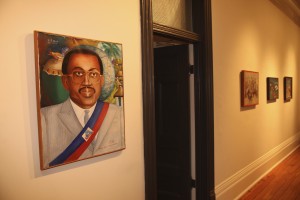
If you’re a Caribbean art lover that missed Candid Aspirations: Color and Imagination in Haitian & Jamaican Art, you certainly missed a treat. Hosted at the swanky Gladstone Hotel, the exhibition ran from September 7-16 showcasing a rare and personal collection of Haitian art by award winning film director Jonathan Demme.
Demme-well known for his work as the director of classics; Silence of the Lambs and Philadelphia starring Denzel Washington, fell in love with Haitian art in the 1980’s. Since then his fondness for Haiti has caused him to produce several documentaries on the Caribbean nation and oversee several fundraising efforts since the devastating earthquake earlier this year. With this latest event, curated by Haitian art enthusiasts Wael Qattan and Jose Zelaya, he certainly brought his passion for all things Haiti to Toronto.
Guests attending the display got a chance to see the work of Haitian geniuses; Philome Obin, Gabriel Alix, Georges Liautaud and Pierre Joseph-Valcin. Also featured, was a vodou temple tour and discussion led by voodoo expert Astrid Jaeger.
Demonstrating his commitment to the promotion of Haitian art, on September 12th Demme himself played host to a special screening of his 2003 film; The Agronomist, which documented the life of activist and Haitian journalist Jean Dominique.
If you missed the show, the Gladstone Hotel will be extending the exhibit from September 24th to November 18th on the 3rd and 4th floor galleries.
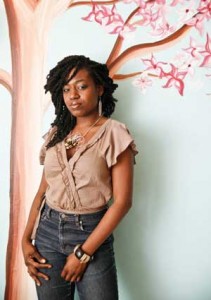 OCCUPATION Visual artist and owner of Sweet Like Mango gift cards and prints
OCCUPATION Visual artist and owner of Sweet Like Mango gift cards and prints
CONTRIBUTION Wignall has emerged as a new dynamic voice in Canada’s art world. Her Afrocentric paintings have won the attention of internationally-acclaimed performers such as singer/song-writer Erykah Badu, and film and television star Vanessa Williams. Wignall’s art celebrates every shade of blackness in boldness and beauty.
INSPIRATION “The African form truly inspires me, our beautiful features, our succulent soul food, the ancestral call in our music and the rich complexions that coat our skin. There’s more to my sisters than what we see of them in hip-hop’s bootylicious videos. And, there is definitely more to my brothers than what we see on the six o’clock news.”
]]>Black artists unleash MAS Hysteria
BY: Jason Roberts
There’s a serious lack of recognition of artwork produced by black visual artists today; all you need to do is visit any local art gallery or museum for evidence to support this claim.
There is, however, one group that is aware of this problem and is taking steps to change it. The group is called SIXAHWI (as in “six of us”), a not-for-profit African-Canadian visual artist collective that began in 1993. Though only one original member, Ato Seitu, remains, the vision and goal is to revolutionize how the world sees and appreciates artwork produced by black visual artists, especially here in Canada.
Performing artist and SIXAHWI visual artist Ashley McKenzie-Barnes believes that now is the time for blacks to play a greater role in the Canadian art scene. “Part of the problem is that African-Canadians need to establish a greater presence as power players within the art market, not just as artists but in other key business roles,” says McKenzie-Barnes. “Black visual artists need to make greater efforts to showcase diversity in their works by producing art pieces that appeal to the ever-changing tastes of people within the artistic community who have grown accustomed to expecting certain work from visual artists of colour.”
With that recognition comes a comprehensive new plan developed by the group that includes increasing their membership and the continued development of a comprehensive art project in the making for four years.
In 2009, the group produced “Mas Hysteria,” an exhibit described by members as a “unique” and “unusual” exhibition that integrates elements of music, dance, drama and visual art into a single presentation. The two-venue showcase debuted at Nuit Blanche in October 2009, and later the same month at the Eleanor Winters Art Gallery at York University. The exhibit highlighted the evolution of Trinidad and Tobago’s mas, the world’s largest theatre of the street. The end goal of the display will be to draw attention to the artistic aspects of mas making, which are often overlooked.
Mas Hysteria, inspired by group member Ras Stone, is a multi-disciplinary art exhibit that will, in addition to more traditional arts displays, have wire sculptures and steel pan players in full mas costume. “These elements will serve to demonstrate how various creative aspects of mas making are examined and represented both historically and within a post-colonial context,” says Stone.
The collective feels that this exhibition, and the upcoming work promised by the group in the future, will contribute to the goal of achieving respect and demand for black art within both black communities and the wider public, thus turning a long-standing dream into reality.
“The show must go on. We have to keep pushing the wood in the fire,” says Seitu. “There is a saying in Jamaica: If you want good your nose has to run.’ We are still pioneers in this time. What we are doing today is really for tomorrow’s generation.”
]]>







